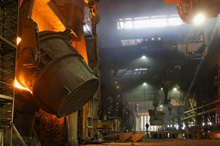
Typical street scene in Santa Ana, El Salvador. (Photo: iStock)
IMF Survey : Economic Structural Change Vital to Successful Development
June 28, 2013
- Structural change involves emergence, expansion of new industries
- A diversified economy is critical for sustained economic growth
- Strategies to improve human capital skills enhances productivity
When a country shifts from being a largely agrarian economy to one based on services or industry, it is said to have undergone “structural change”. This has happened in some Asian countries, contributing largely to their economic development. Many low-income countries, however, have yet to undergo this process of structural transformation.

Steel mill in Beijing, China. The country’s rapid industrialization was an essential part of its successful development (photo: Corbis/Liu)
Sustainable Growth
How then, can countries undertake structural change and diversify their economies? Harvard University professor of economics, Dani Rodrik, spoke to IMF Survey, and explained why structural change is so critical to development.
IMF Survey: What are the key ingredients for sustained growth in a country?
Rodrik: I think all sustained episodes of growth are underpinned by fundamental structural change. Of course, you can get growth spurts because of an improvement in the terms of trade or a sudden burst of capital inflows. But those tend to peter out unless there is the emergence and expansion of new industries, and movement of labor from traditional industries into modern industries. This is the essence of structural change. Without these things happening, a country is not likely to achieve long-term growth.
IMF Survey: Asia is an example of a region where structural change has been very positive for growth.
Rodrik: That is correct. Asia has been the archetypal example of a traditional model of economic development for those economies with surplus labor and very low productivity levels, which are dependent on subsistence agriculture.
Then, new industries started to emerge, mainly in urban areas, and although still poorly educated, farmers became more productive factory workers. They were able to increase their income, and could send their children to school. This increased productivity has also set in motion a self-sustaining process of improvement in human capital skills.
It has happened in many Asian countries—Japan being the earliest example of a non-western country to industrialize. South Korea and Taiwan quickly followed, and from the 1960s through late 1970s, more Southeast Asian countries became industrialized, most notably China.
What is key to their success, I believe, is their pragmatism. That is, these Asian countries have focused on achieving rapid industrialization through outward-oriented, or export oriented, industrialization. They have been very pragmatic and eclectic in the types of instruments they used. It is equally the capabilities of the state, their pragmatism, and the willingness of the government in each of those counties to enter into collaborative arrangements with the private sector. So, a lot of factors have colluded to make their strategy more successful.
IMF Survey: What would be some barriers to structural transformation in regions where this has not happened?
Rodrik: Often, in the less successful cases—such as in some African and Latin America countries—what we have seen is an obsessive attachment to a particular ideology. For example, during the 1960s and 1970s, many countries took import substitution to extremes. Then, in the 1990s, these countries adopted the orthodoxy of a “Washington Consensus,” which basically urged countries to forego any structural change policies. They were encouraged to focus on the fundamentals, and structural transformation would follow automatically. This did not quite work out for them.
IMF Survey: On a broader level, what would be some policy recommendations in terms of supporting diversification and structural transformation?
Rodrik: We need to start with diagnostics. A country should have a fairly good idea of what is blocking structural transformation. Is it that labor market imperfections discourage formal or existing enterprises to grow? Is it a credit constraint? Is it a country’s financial markets that are performing poorly? Is there an extractive political institution that turns away investors because nobody wants to invest in visible modern enterprises for fear of being expropriated one way or another by the government?
The principle concern, then, is for a country to do its homework and figure out what are the problems that would affect structural change.
IMF Survey: What about countries that are rich in natural resources? It seems to be a particular challenge for these countries to diversify.
Rodrik: Yes. Those countries come with a set of advantages and the belief that having natural resources can make them richer more quickly. But there is also the disadvantage of being natural resource rich, because the country can suffer from so-called “Dutch disease,” which means that non-natural resource sectors tend to be very unprofitable. For example, those countries exporting natural resources like oil or copper may find it much harder to use modern manufacturing techniques competitively.
There is really no good way out of this situation. I think the amount of diversification that can be achieved by resource-rich countries is limited compared to some of the Asian countries that started out being resource poor. For example, Saudi Arabia or Nigeria may never achieve the kind of manufacturing miracle that China or South Korea has experienced.
So, as a medium- to long-term strategy, I believe the best route for those resource-rich countries looking to diversity is to develop the fundamental capabilities and skills of their human capital to help improve productivity in the service sectors, rather than focusing solely on manufacturing. While this is a longer process, they have still the cushion of natural resource wealth in the short term.


